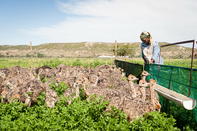Ostrich production in South Africa is unique in the sense that it is a low-carbon footprint, sustainable and socially responsible farming system that produces healthy and lean animal protein and by-products of high quality in rural areas, often associated with arid climates.

Ostrich Production Systems
Ostriches can be farmed in intensive free-range systems, which accommodate basic rights of freedom or in extensive systems. Extensive ostrich farming systems are carefully managed to protect the environment and natural vegetation.
The ostrich breeding season is eight months, followed by a rest period of four months. Eggs may be hatched by the breeding pair, but most often, eggs are collected after laying and transferred to hatcheries with incubators, for an incubation period of 42 days.
Female ostriches produce 40 - 60 eggs per breeding season. After laying an initial clutch (a group of eggs), the dominant female starts the incubation with the male. An ostrich hen, in a female group, will lay every other day.
Eggs are collected daily, inspected, cleaned and incubated in artificial incubators. The hen will always be left with a few nest eggs to hatch so as not to upset her future reproductive cycle. In these artificial incubators, temperature and humidity are carefully regulated and eggs are rotated 4 to 8 times per day, to allow for the proper development of the chicks.
Newly hatched ostrich chicks are very sensitive, therefore, very careful and dedicated management is required. Chicks are kept in facilities very similar to their natural environment and quickly form social clusters, often bonding with their human carers.
Ostriches are very fast-growing and can achieve a slaughter weight of about 90 kg in 10 - 12 months. They are taken to specialised ostrich abattoirs, that comply with and are certified to European standards. Processing allows for complete utilization with no wastage.
Feathers, meat and leather are the products produced. At specialised processing plants, ostrich skins are tanned before being sent on for further processing into leather goods and feather products. Ostrich meat is cut into fillets, steaks and trimmings and can be sold fresh or frozen as raw or pre-grilled.
Ostrich Production Figures
According to the ‘Profile of the South African Ostrich Market Value Chain’ (2017) compiled by the Department of Agriculture, Forestry and Fisheries (DAFF), the average gross value of ostrich production in South Africa amounted to R391 million over the past ten years.
There was a peak in production in 2009/10 to the value of R514 million (9 201 tonnes) and another peak in 2015/16 at almost R530 million. Drastic decreases were due to the outbreak of avian influenza (bird flu) in April 2011. This has led to the culling of 50 000 ostriches.
In 2015, South Africa was declared disease-free, which lead to an increase in exports, which picked up in 2016 with a 120 % increase from 2015. According to Mosstrich, ostrich abattoir in Mossel Bay, about 3 640 tonnes of ostrich meat was produced in 2018.
Before the ban in 2011, exports of South African ostrich meat and products contributed about R1.2 billion annually. Up to 2011, about 98% were exported to the European Union and the rest to African and the Far East - mostly Hong Kong (72%) and Vietnam (15%).
The bulk of South African ostrich meat was exported to Belgium (42%) followed by Germany (17%), Netherlands (15%), France (13%), and Switzerland (9%). The United Kingdom has been the lowest importer with only 1% of the total of EU exports.
After 2011 there were no exports to Asia, according to DAFF. In terms of export to Africa and beyond, figures - peaking in 2014 - saw Mauritius importing the most (10 600 kg), followed by Zimbabwe (6 000 kg) and Mozambique (4 600 kg).
By Marinda Louw
For bulk or Ostrich export enquiries please use the enquiry link below.